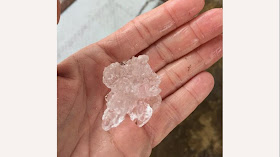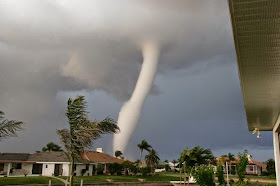With storm season in full swing, Oklahomans are encouraged
to take steps to protect themselves, their families and their property from
damage caused by tornadoes, high winds and hail.
Hail
Hail alone causes approximately $1 billion in damage to
property each year, according to the National Oceanic and Atmospheric
Administration. Oklahoma Farm Bureau Insurance offers these tips in the event
of a hailstorm:
• Know what’s covered under your policy. Homeowners and
automobile insurance generally provides coverage for property damage caused by
hail, but not all policies protect against hail damage. Double check your
policy and contact your agent to ensure you have comprehensive coverage before
damage occurs.
• Protect against further damage. If your property or
vehicle is damaged due to severe weather, take immediate action to prevent
further damage or theft as soon as it is safe to do so. Use plywood, tarps or
other materials to cover broken windows and damaged rooftops, and save receipts
of any materials used to make repairs. Provide these receipts to your adjuster
for review and reimbursement of expenses covered by your policy. Take photos or
video of the damage, and keep them on file in case you need to reference them
later.
• Choose a reputable repair company. Once approved by your
insurance company, select a contractor or repair shop to help fix any damage
that has occurred. Be wary; it’s not unusual for scammers to pose as a repair
company after a damaging storm. Choose a company that has operated in your area
for several years, is insured and bonded and will give you a written guarantee
for the work performed.
• Prevent damage with weather-resistant products. Advances
in roofing material production have led to the development of hail and
wind-resistant roofing materials, which can be an effective method for
homeowners to mitigate roof damage. The national standard for roof impact
resistance is a material rating system of Class 1 through 4, based on their
resistance to impact testing with steel balls simulating 90-mph hailstones of
varying sizes, with a Class 4 rating being the toughest.
Tornadoes and high winds
Those who find themselves driving in a tornado or high winds
are encouraged to follow these safety tips from AAA Oklahoma:
• If a tornado warning is issued for your area, leave your
vehicle immediately and seek shelter in a sturdy building.
• Never try to outrun a tornado. Your car or pickup will
offer no protection from a twister. It is impossible to know which direction a
tornado may decide to go.
• Seek shelter indoors. A basement is safest. Closets or
small interior rooms are best. Stay away from south walls, west walls and all
windows. Get under a solid piece of furniture or a mattress.
• If you are caught in the open with no substantial
buildings available, find a ditch, ravine or low-lying area and lie flat. Stay
away from roadway overpasses.
• Do not seek shelter in a mobile home. These structures,
even if tied down, offer little protection from tornadoes and should be
abandoned.
• Remember, wet roads mean poor traction. Conditions are
most dangerous during the first 10 minutes of a heavy downpour as oil and
debris wash away. Driving on wet roads in the rain is like driving on ice. Slow
down. Take it easy. Allow extra time to reach your destination.
• Never use your motor vehicle’s cruise control feature in
rainy weather.




















